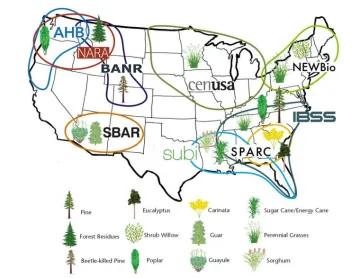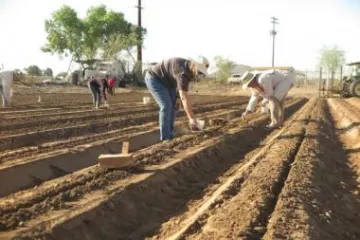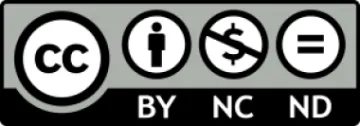

Who We Are
The Sustainable Bioeconomy for Arid Regions (SBAR) Center of Excellence was established in September 2017, with the intended purpose of developing a systems approach for feedstock development, production, and delivery in the Southwest United States. It is further enhanced by the development and implementation of education, extension and outreach to teachers, 4-H youth groups, and farmers across the region.
What We Do
SBAR works to optimize and integrate the production of guayule and guar to enable the Southwest United States to significantly impact the biofuels and other high-value product markets. Scientists are collaborating on research, development, and deployment (RDD) activities to:
- Improve feedstocks and produce them in a sustainable manner;
- Identify new value-added co-products that increase marketability;
- Understand how conversion to fuel is affected by variable feedstock quality; and
- Augment transportation, techno-economic, and sustainability models to provide a clear path to commercialization.
These RDD activities are complemented by bagasse conversion and upgrading to fuel via pyrolysis, hydrothermal liquefaction, and acid hydrolysis.
Our Vision
To provide stakeholders, interested in expanding crop options that support the rubber and biofuel industries, with regional solutions that are economically viable, socially acceptable, and meet the water conservation needs of the arid Southwest (AZ, CA, NM, and TX).

How We Inform
The Extension and Outreach Team serves as a conduit between researchers and community stakeholders, helping to transfer the science and technology of guayule and guar production to communities in the Southwest. They provide resources like research results, bulletins, videos, webinars, field tours, youth camps, and workshops on biofuels and other energy issues.
To engage citizens, meet future workforce needs, and enhance science literacy in agriculture and biofuels, the Education Team creates and disseminates K-12 biofuel curriculum. Program implementation includes mentoring Graduate Student Fellows and teachers in Arizona and New Mexico. Summer and school-year internships are provided to high school students and undergraduate students on a variety of agriculture and biofuel topics.
Why Biofuels in the Southwest Matter
Water Conservation: Using desert-adapted plants for generating rubber and fuel reduces water required for rubber and fuel production.
Economy: Job creation and rural development is enhanced throughout the region.
Energy Security: Locally produced natural rubber and fuel reduces the dependence on foreign natural rubber and fuel.
Environmental Benefits: Guar can be grown in crop-rotation and fixes nitrogen in the soil, reducing the need for high inputs like herbicide and fertilizers for future crops. Guayule uses less water than traditional crops over 2 years.
Infrastructure Compatible: The natural rubber produced is chemically equivalent to Hevea-based rubber and chemicals.
Project Funding
The Sustainable Bioeconomy for Arid Regions (SBAR) Center is led by the University of Arizona and funded through a research and education/extension grant provided by the USDA National Institute of Food and Agriculture (NIFA) – Agriculture and Food Research Initiative. Grant # 2017-68005-26867.

Creative Commons
This website is developed and maintained by the SBAR Administrative Team. Our work is offered under Creative Commons licenses. All work on this site falls under the Attribution-NonCommercial license CC BY-NC-ND 4.0, unless otherwise noted.
This license allows others to download our work and share them with others as long as the work acknowledges SBAR, and the appropriate member where applicable. The work cannot be changed or used commercially.
Credits
Icons from TheNounProject.com
- leaf by Saeful Muslim, ID - CC BY
- Logistics by Becris - CC BY
- Sustainability by Lizzy Gregory - Public Domain
- education by sobinsergey, RU - CC BY
- Tractor by Iconic - CC BY
- Information by Nithinan Tatah, TH - CC BY
- Art Supplies by Made - CC BY
- Report Trend by Eucalyp - CC BY
- green energy by sasha willins, US - CC
- User by sagar ghate - CC
- edit by SBTS - CC
- leaf by SBTS - CC
- tractor by Ron Scott - CC
- old tractor by Robert Bjurshagen - CC
- graduate by Hopkins - CC
- Excel Files by Joan Ang - CC
- chart by Setyo Ari Wibowo - CC
- Substitution by Adrien Coquet - CC
- Money Plant by popcornarts - CC
- opportunity cost by Amethyst Studio - cc
- famine by OCHA Visual - cc
- Supply and Demand by M. Oki Orlando - CC
- depreciation by Phạm Thanh Lộc - CC
- inflation by Studio 365 - CC
Photos from Wikimedia Commons
- Businessman with a newspaper (Unsplash) by rawpixel.com
- Entering Arizona on I-10 Westbound by Wing-Chi Poon
- Guar seeds by Ton Rulkens
- NRCSAZ84005 - Arizona (503 NRCS Photo Gallery) by Tim McCabe, USDA NRCS
- NRCSAZ02012 - Arizona (307 NRCS Photo Gallery) by Jeff Vanuga, USDA NRCS
- NRCSAZ02037 - Arizona (357 NRCS Photo Gallery) by Jeff Vanuga, USDA NRCS
- Open book color by Bibliothek Wissenschaftspark by Albert Einstein
- Tractors Plowing Field - NARA - 545893 by Blair Pittman, 1937 [sic]
- Cyamopsis tetragonoloba (4663783848) by Dinesh Valke
Photos from pexels.com
- alphabet-blur-books-close-up-301920 by Pixabay - CC 0
- analyzing-dark-dof-256262 by Pixabay - CC 0
- light-landscape-nature-red-33041 by Paul IJsendoorn - CC 0
- nate-hovee-4656946 by Nate Hovee - CC 0
- pexels-pixabay-267885 by Pixabay - CC 0
Photos from flickr.com
- Sunset @ Yaki Point, Grand Canyon National Park by Nagarajan Kanna - CC by-nc-nd
- Chemistry! by Matthew Frederickson - CC by-sa

